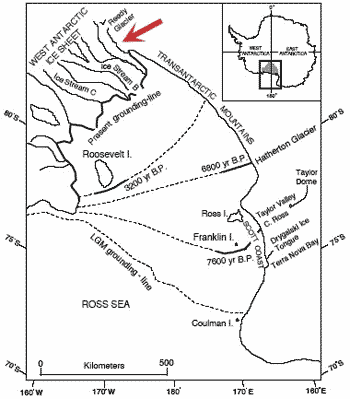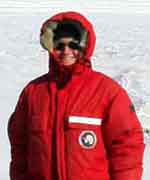Claire Todd, John Stone, Howard Conway, and Maurice Conway (UWashington)
November 18, 2003 to January 1, 2004
We will reconstruct the level of Reedy Glacier, in the far southern Transantarctic Mountains, from the LGM (Last Glacial Maximum) through to the present day. Because the grounding line has not yet passed Reedy Glacier, it, unlike other outlet glaciers crossing the Transantarctic Mountains, will have recorded recent changes in the thickness of ice in the Ross Sea. The deglaciation chronology of Reedy Glacier therefore can indicate whether Holocene retreat of the WAIS (West Antarctic Ice Sheet) grounding-line ended thousands of years ago, or is continuing at the present day. We will carry out an integrated glaciologic, glacial-geologic, and exposure-dating project to map and date past levels of Reedy Glacier. We will map moraines and erratic distributions at sites along the length of the glacier. We will date the moraines directly with cosmogenic isotopes, and, if possible, couple these results with radiocarbon dates on organic material from ice-marginal melt ponds. This will allow us to correlate moraines along the glacier and to establish its gradient through time. We will obtain radar profiles across the glacier at several locations and measure present-day flow speeds with GPS, as the basis for developing a flow-line model to relate our observations to the grounding-line position downstream. Ultimately, the mapping, dating and ice-modeling components of the study will be integrated into a reconstruction that defines changes in ice thickness in the southernmost Ross Sea since the LGM, and relates these changes to the history of grounding-line retreat. For more details, see the project page.
Friday December 26, 2003
click on a photo to see it full size




Gordon Reports from the Quartz Hills:
Today is our camp move, when we shall be relocating from the Quartz Hills to the Calaplaca Hills, about ten miles further up the Reedy Glacier. The Scott tents are coming down and all food and equipment is being packed into boxes and cargo bags for the move. This is our second attempt to make this move, our first being a complete failure due to bad weather on the 23rd. That day we’d already collapsed all our tents and piled everything neatly by the airstrip on the glacier, waiting for the Twin Otter aeroplane to pick us up and ferry the group to the new camp. Imagine our disappointment when the pilots regretfully told us that, after all that, visibility was too poor for a flight to the Calaplaca Hills, and that they’d have to leave us to put our camp back together again! Fortunately, the weather today is perfect for flying, not too windy and beautiful sunshine.
Our work has progressed quickly in the Quartz Hills. Brenda and I have mapped many series of moraines and drift limits, some of them very old indeed, and have also discovered clues as to the nature of the Reedy Glacier at various times in the past. A good number of pits have been dug into these landforms, and sediment and ice samples taken. Claire and John have taken hundreds of rock samples for cosmogenic dating, and I was able to join them on one occasion to observe the rather delicate collection procedures. Twit and Maurice Conway, who were also with us, have been profiling the glacier with radar, and have installed a network of points from which they can measure the glacier flow velocity by next year.
Life in the camp has been surprisingly comfortable, with day after day of sunshine (except on our failed camp move day!) and relatively warm temperatures (17° to 22° F typically), snowmobile transport to our desired destinations and some very good cuisine. Some evenings we would enjoy steak or shrimp, whilst Saturdays were reserved for Maurice’s pizzas and Sunday mornings for Brenda’s pancakes. Comparatively, lunch is rather boring, with most items, like peanut butter and dried fruit, at least two years out of date, and tasting it too! Christmas dinner, however, was a great success, and was supplemented with little presents, crackers (with terrible jokes) and a fine, though limited, cellar of wine. There was even a Christmas tree, carved out of hard snow and adorned with decorative tea bags, though sadly this didn’t last long in the wind. Now the plan is to move camp to a suitably comfortable spot, and continue our work for another week or so.
Wednesday December 31, 2003
Gordon writes from McMurdo:
Back in McMurdo now after a successful field season, time for a much-needed shower! Our return journey from the Reedy Glacier was very smooth, flying first to the South Pole, where we stayed the night, and then back to McMurdo on a Hercules. Being at 10,000 ft, the Amundsen-Scott Base at the South Pole is high enough to give me a bit of a headache and make simple acts like climbing the stairs a little more difficult. It is a nice place to be though, a flat plain of white in all directions, and quite a novel experience to be right at the bottom of the world. And, of course, we took the obligatory group photographs.
Our visit to the Calaplaca Hills was brief but beautiful, really the most stunning scenery imaginable, with vast wild glaciers and the towering Transantarctic Mountains as a backdrop. We managed to camp on probably the only dangerously big crevasse on the whole glacier, which, hidden under the snow, was only discovered when it was time to leave. We started running out of food at this point too, things like jam and cereal, and tea bags, so it is probably a good thing that we were only there a short while! I also managed to break an expensive-looking skidoo ski, which just snapped in half whilst driving across the blue ice of the glacier. As far as work goes, we managed to reconstruct some glacial limits sufficiently, though there still remain more mysteries to be puzzled over next year, when hopefully, we shall return to the site.




